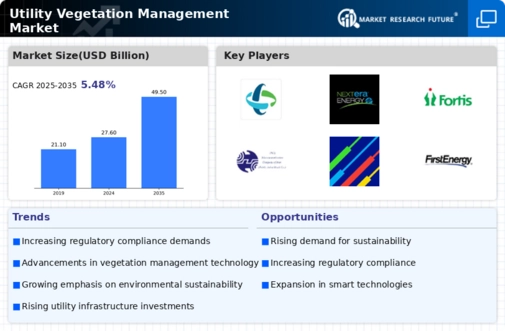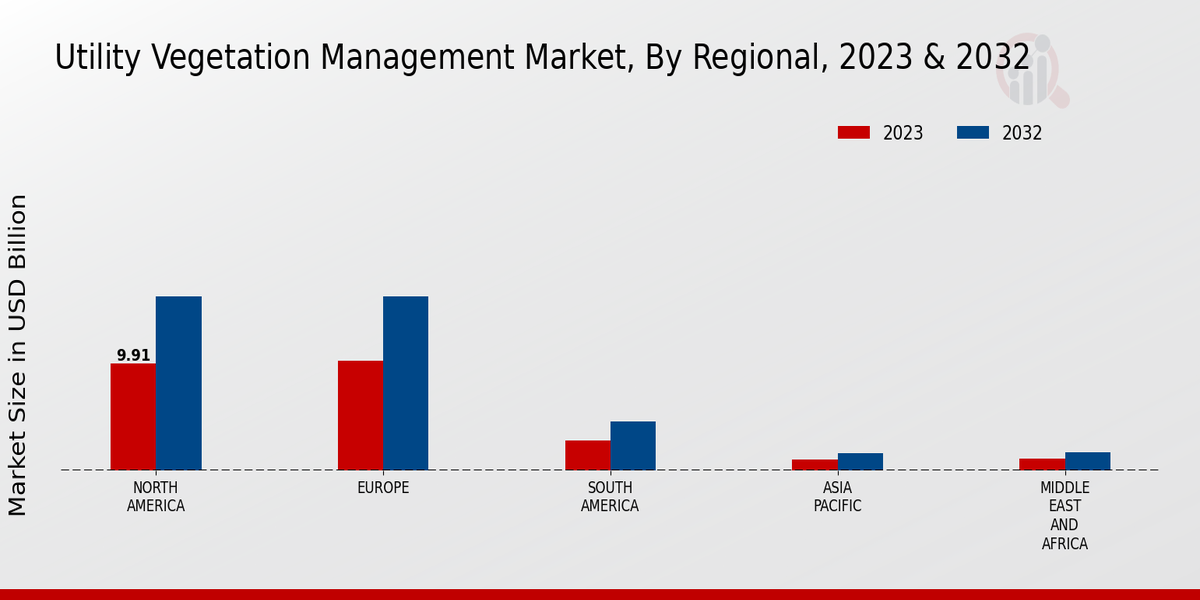Market Growth Projections
The Global Utility Vegetation Management Market Industry is projected to experience substantial growth in the coming years. With a market value of 27.6 USD Billion in 2024, it is expected to reach 49.5 USD Billion by 2035, reflecting a robust CAGR of 5.48% from 2025 to 2035. This growth trajectory indicates a strong demand for effective vegetation management solutions as utilities prioritize reliability, safety, and sustainability. The increasing frequency of extreme weather events and regulatory pressures further contribute to this upward trend, suggesting a dynamic and evolving market landscape.
Regulatory Compliance and Safety Standards
Regulatory compliance plays a crucial role in shaping the Global Utility Vegetation Management Market Industry. Governments and regulatory bodies impose stringent safety standards to minimize risks associated with vegetation encroachment on power lines. Utilities are compelled to adopt comprehensive vegetation management programs to adhere to these regulations, which often include regular inspections and maintenance. As a result, the market is witnessing a surge in demand for services that ensure compliance with evolving safety standards. This trend is expected to contribute to the market's growth, with projections indicating a rise to 49.5 USD Billion by 2035, as utilities prioritize safety and regulatory adherence.
Increasing Demand for Reliable Power Supply
The Global Utility Vegetation Management Market Industry experiences a growing demand for reliable power supply, driven by the need to prevent outages caused by vegetation interference. As utilities strive to enhance service reliability, effective vegetation management becomes paramount. In 2024, the market is projected to reach 27.6 USD Billion, reflecting the industry's commitment to maintaining clear rights-of-way. This focus on reliability is further emphasized by the increasing frequency of severe weather events, which necessitate proactive vegetation management strategies to mitigate risks. Utilities are investing in advanced technologies and practices to ensure uninterrupted power delivery, thereby bolstering the market's growth.
Rising Urbanization and Infrastructure Development
Rising urbanization and infrastructure development significantly impact the Global Utility Vegetation Management Market Industry. As urban areas expand, the demand for reliable utility services increases, necessitating effective vegetation management to prevent outages and ensure safety. Urban vegetation management becomes critical in densely populated areas where power lines are often in close proximity to trees and other vegetation. This trend is expected to drive market growth as utilities invest in proactive vegetation management strategies to accommodate urban expansion. The increasing complexity of urban infrastructure further emphasizes the need for comprehensive vegetation management solutions that address the unique challenges posed by urban environments.
Technological Advancements in Vegetation Management
Technological advancements significantly influence the Global Utility Vegetation Management Market Industry by enhancing the efficiency and effectiveness of vegetation management practices. Innovations such as remote sensing, drones, and Geographic Information Systems (GIS) enable utilities to monitor vegetation growth and assess risks more accurately. These technologies facilitate data-driven decision-making, allowing for timely interventions and optimized resource allocation. As the industry embraces these advancements, the market is poised for growth, with a projected CAGR of 5.48% from 2025 to 2035. The integration of technology not only improves operational efficiency but also contributes to enhanced safety and reliability in power delivery.
Growing Environmental Awareness and Sustainability Initiatives
The Global Utility Vegetation Management Market Industry is increasingly influenced by growing environmental awareness and sustainability initiatives. Utilities are recognizing the importance of sustainable practices in vegetation management to minimize ecological impacts. This shift towards environmentally friendly approaches includes the adoption of integrated vegetation management strategies that promote biodiversity and ecosystem health. As consumers and stakeholders demand more sustainable operations, utilities are compelled to align their practices with these expectations. This trend is likely to drive market growth as utilities invest in sustainable vegetation management solutions, thereby enhancing their corporate social responsibility profiles and meeting regulatory requirements.
























Leave a Comment